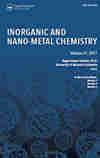SILAR Deposition of Ni(bpy)3X: {X = (NCS)2, (Fe(CN)5NO), and (Ag(CN)2)2} Thin Films on Glass Substrates
Synthesis and Reactivity in Inorganic, Metal-Organic, and Nano-Metal Chemistry
Pub Date : 2016-05-27
DOI:10.1080/15533174.2015.1137055
引用次数: 6
Abstract
The authors focused on the preparation of thin layers based on hybrid materials (organometallic complexes) deposited onto glass substrates. The deposition experiments of [Ni(bpy)3](NCS)2, [Ni(bpy)3](Ag(CN)2)2, and [Ni(bpy)3](Fe(CN)5NO) were performed on glass slides (18 mm × 18 mm) by successive ionic layer adsorption and reaction (SILAR) method. The influence of some parameters, such as dipping cycle numbers (30, 60, and 120 dipping cycles), temperature (20°C, 30°C, 40°C, and 50°C), precursors concentration (10−3, 10−2, and 10−1 M), and the nature of the counteranions (NCS−, [Fe(CN)5NO]−2, [Ag(CN)2]−) were studied. Different methods (UV-Vis, SEM, FTIR, and XRD) were used to characterize the deposited layers to determine the absorption coefficient (α) and gap energy (Eg) of the materials.Ni(bpy)3X: {X = (NCS)2, (Fe(CN)5NO)和(Ag(CN)2)2}薄膜在玻璃基板上的SILAR沉积
作者着重于制备基于杂化材料(有机金属配合物)沉积在玻璃衬底上的薄层。采用连续离子层吸附反应(SILAR)法在18 mm × 18 mm的玻片上进行了[Ni(bpy)3](NCS)2、[Ni(bpy)3](Ag(CN)2)2和[Ni(bpy)3](Fe(CN)5NO)的沉积实验。研究了浸渍循环次数(30、60和120次)、温度(20℃、30℃、40℃和50℃)、前驱体浓度(10−3、10−2和10−1 M)和反阴离子(NCS−、[Fe(CN)5NO]−2、[Ag(CN)2]−)性质等参数的影响。采用不同的方法(UV-Vis, SEM, FTIR和XRD)对沉积层进行表征,测定材料的吸收系数(α)和间隙能(Eg)。
本文章由计算机程序翻译,如有差异,请以英文原文为准。
求助全文
约1分钟内获得全文
求助全文
来源期刊
自引率
0.00%
发文量
0
审稿时长
5 months

 求助内容:
求助内容: 应助结果提醒方式:
应助结果提醒方式:


